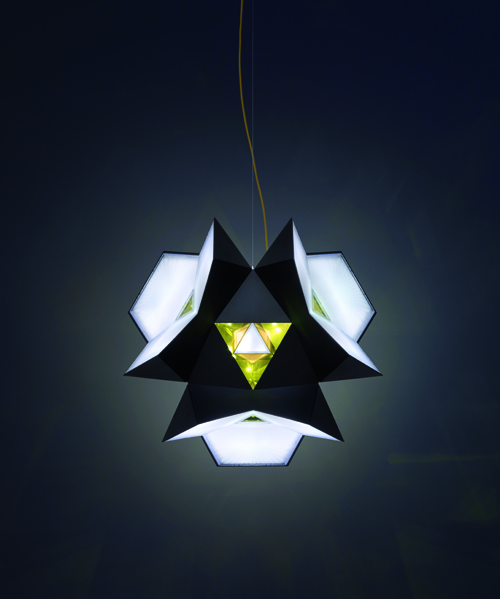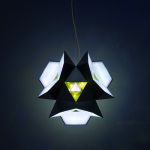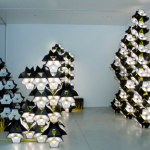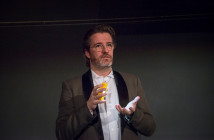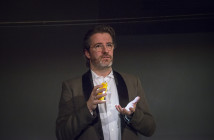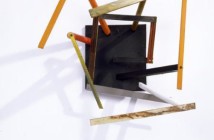For the past few columns I have focused on artists who began their careers – and built reputations - with work marked by a ruthless economy of means. Many artists who start with low cost materials and innovative production methods wind up with enterprises that spend exorbitant amounts of money in the developing, producing and maintenance of their artistic practice (Chris Burden was my last subject). My interest in tracing this trajectory is not to evoke a cynical mistrust of expensively produced artwork, but to question how much, if at all, more advanced production methods have complemented or expanded on earlier, more distinctly modest efforts. Olafur Eliasson is certainly no stranger to large-scale works with advanced engineering. His "Weather Project" in Turbine Hall at the Tate Modern, along with his "New York City Waterfalls" in the summer of 2008, are two of most discussed projects of the last decade, not to mention some of the most expensive. However, like most entrepreneurs, Eliasson embraces diverse forms of output. In particular, his latest product packages his light and space experiments into a mass-produced modular component.
I first saw the ad for Eliasson's "Starbrick" while leafing through Artforum's December issue. The ad itself struck me as slightly out of place, as it wasn't promoting an exhibition per se, only a mysterious star shaped light, seemingly sponsored by Zumtobel, who I later learned is an innovative LED manufacturer aiming to establish, "lighting standards into luminaire designs." A visit to "Starbrick's" website is something of a lesson in product promotion. The copy throughout the site is minimal, technical, factual, yet focused and confident. The many commercial photos effectively document and illustrate the many possibilities for assemblage: Groups of any size and combination and in multiple directions can sit on the floor, attach to walls or hang from the ceiling. As with all things modular, the installations are seemingly endless in their multiplicity and promote bulk buying, or at least, options during purchasing. It is difficult to imagine a moment when high-end product development and conceptual art were more palpably linked.
While Eliasson has certainly worked with modular sections in previous installations, never, to my knowledge, has the work been sold online and so non-exclusively. Reservations are made starting January 2010 and shipping begins in February, presumably to anyone with 2,450.00 Euro (roughly $3,465 dollars). As with all forms of art that have blatant relationships with commerce (i.e. Murakami Prada bags) It isn't exactly clear how this gesture should be read. However, the clear goal of domesticating Eliasson's work is mildly confounded by Eliasson's own usage of the product. For his solo exhibition "Your Chance Encounter" at the 21st Century Museum of Contemporary Art in Kanazawa, Japan, Eliasson used many units of Starbrick to "challenge the visitor's sense of movement and orientation," according to the website. In other words, he used the unit in much the same way he would any other material.
In one way, Eliasson's usage of Starbrick in Japan simply created yet another variable work for a museum show, and it just so happens that this particular installation is made up of interchangeable modules that can sell individually. Another take could view his installation not necessarily as an environment to experience, but a display to give consumers ideas. His "Starbrick" installation, arranged in an assortment of configurations, give consumers (at least those who have the money to buy a few bricks) a starting point for possible home installations, likening the exhibition space to a store. Consumers are theoretically empowered with choice of design, tailored to their own space and taste. A more cynical take is that Eliasson is using the 21st Century Museum of Contemporary Art as something akin to an advertisement, space dedicated to promoting a new Eliasson product line.
Modular arrangements have the remarkable that allow one to mentally add or subtract from a whole. In virtually any arrangement, one can intellectually de-assemble and assemble the whole. The ability to de-construct how one experience's an environment is a theme that Eliasson has developed from earlier works. In his first solo museum exhibition at the ICA Boston (when it was still in the old firehouse) in 2000, Eliasson's presented an installation in which a pool of water was built with 2 x 4s and plywood and other common building materials. Seeing this humble ramshackle structure as you climbed the stairs to see the pool was an integral part as to how one experienced the work. The temporal parts made one approach the viewpoint above with some trepidation and excitement. This viewpoint at the top of the stairs enabled viewers to gaze at the room-sized pool that encompassed a hanging swirl of neon reflecting in the pool of water. The calming beauty of the artificial reflection was only intensified by the temporal, unfinished quality of its fabrication. One could imagine the work's dismantling upon the exhibition's closing, only to go back to the lookout and see only water and neon. In this sense, the viewer experienced both the work's construction and completion through their time spent. Hence, the title of the exhibition: "Your Only Real Thing is Time."
De-Assembling a large installation of "Starbricks" also reflects its construction process, however, it mirrors the design and ultimate abstraction of high-end industrial fabrication. In short, with these two works, Eliasson swapped common wood building materials for injection-molded polycarbonate components backlit by LED lights.
It is tempting to look the transformation of modest, yet ambitious carpentry, to industrial production as one of advancement. After all, the complicated molding and lighting processes that control the majority of Eliasson's work is certainly something to marvel at. However, to say it advances his ideas in more meaningful ways is questionable. The process for a design object like this takes the work of a full team that includes: A draftsman, a host of engineers, a web and graphic designer, a copywriter, a technical writer to draft the instructions, not to mention the tooling and shipping teams to manage the fabrication and subsequent distribution. Contrary to this expansive team, the works at "Your Only Real Thing is Time" were likely executed with a few crude drawings and a host of arthandlers to execute them.
What this project attests to is the seamless convergence of industrial design, product promotion and the discourse of art. This is not advancement so much as art becoming more commercial. Which is to say, more "accessible" by way of affordable sales. However, with art and with business, more growth can often mean the loss of your original base of customer. This project seems reminiscent of every company's ascension: the more they grow, the more you wish they could have stayed small.
- Starbrick, © Olafur Eliasson and Zumtobel. Photo: Jens Ziehe
- Starbrick at 21st Century Museum of Contemporary Art, Kanazawa, Japan. Photo: Olafur Eliasson

